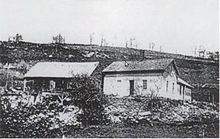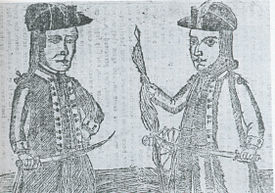- Daniel Shays
-
Daniel Shays (c.1747 – September 29, 1825) was an American soldier, revolutionary, and farmer famous for leading the Shays' Rebellion.
Contents
Early life
Daniel Shays was born in 1747 in Hopkinton, Massachusetts, the son of two Irish immigrants, Patrick and Margaret (Dempsey) Shays. Daniel was the second of six siblings. He spent his early children years as a landless farm laborer. In 1772, he married Abigail Gilbert, with whom he settled in Brookfield, Massachusetts.[1]
Revolutionary War
Shays joined the local militia during the American Revolution, rising to the rank of captain in the 5th Massachusetts Regiment by 1777.[1] He was involved in the Boston campaign, and fought at the Battle of Bunker Hill.[2] He also fought in the Battle of Lexington and the Battle of Saratoga. He was wounded during the war and resigned from the military, unpaid, in 1780. Upon returning home, he discovered he was summoned to court for unpaid debts, which he still could not pay because he was not paid for military service.[3]
In 1780, Shays was presented with an ornamental sword by General Lafayette, in honor of his military service. Shays later sold the sword for a few dollars to pay off his debts -- an act which was frowned upon by his peers.[4]
Shays' Rebellion
After returning from the war, Shays was alarmed to discover that many of his fellow veterans and farmers (called Shaysites) were in the same financial situation as he. Commoners' meetings revealed that veterans were treated poorly upon release, and businessmen were trying to squeeze money out of smallholders in order to pay their own debts to European war investors. Shays and the Shaysites first tried to petition the legislature in Boston.[5] After several years of petition and popular conventions in Boston failed, Shays and the rest of the Shaysite leaders decided that a different sort of action had to be taken.[citation needed]
In 1786, Shays became one of several who took command of units of rebels. The uprising soon became known as the "Shays' Rebellion" after an encounter between a force of about 800 farmers under Shays, and a mercenary unit of roughly the same size, at Springfield on September 26, 1786. Four men were killed[6]- the first casualties of the rebellion – and many were wounded. Shays and his men were trying to prevent the Massachusetts Supreme Court from convening, fearing indictments against farmers in arrears.[citation needed]
By the winter of 1786, there was open fighting between government forces and rebels. After several skirmishes, Shays and his men were defeated at Petersham, Massachusetts on February 2, 1787. Shays then fled to the Vermont Republic. Condemned to death in absentia on a charge of treason, Shays petitioned for amnesty in February 1788, and the petition was granted by John Hancock on June 13. Shays then relocated to Rensselaerville, New York.[citation needed]
The rebellion was used as a reason to end the Articles of Confederation. These arguments led to more support for a stronger federal system to counter any future rebellions. The Virginia Plan which promoted a stronger federal system was adopted over the New Jersey Plan as a blueprint for the US Constitution partly as a response to Shay's Rebellion.[citation needed]
Later life
Shays was later granted a pension by the federal government for the five years he served in the Continental Army without pay. Shays lived the last few years of his life in poverty, a heavy drinker. He supported himself on his pension, and by working a small parcel of land.[7] He died at age 78 in Sparta, New York.[7]
References
- ^ a b Brown, Lorri (2010). "Shays, Daniel (1747–1825)". In Danver Steven L.. Revolts, protests, demonstrations, and rebellions in American history: an encyclopedia. ABC-CLIO. p. 220. ISBN 9781598842210. http://books.google.com/books?id=A1C4W2IVHcMC&pg=PA220.
- ^ Leonard L. Richards (2003). Shays's Rebellion: The American Revolution's Final Battle. University of Pennsylvania Press. p. 95. ISBN 9780812218701. http://books.google.com/books?id=b5SuRY9pppgC&pg=PA95.
- ^ Zinn, Howard. A People's History Of The United States. New York: Harper, 1995. 71–72
- ^ Gross, Robert A. (1993). "The Uninvited Guest: Daniel Shays and the Constitution". In Gross, Robert A.. In Debt to Shays: The Bicentennial of an Agrarian Rebellion. University Press of Virginia. p. 1. ISBN 9780813913544. http://books.google.com/books?id=HpSIYclyYogC&pg=PA1.
- ^ Zinn, 91–93
- ^ David P. Szatmary, Shays' Rebellion: The Making of an Agrarian Insurrection, p. 102: "In desperation the militiamen then aimed two cannons directly at the rebels and fired fourteen or fifteen rounds of grapeshot into their ranks. When the smoke cleared, the blood of four dead and twenty wounded farmers stained the snow-covered ground around the arsenal as the bulk of the farmers retreated from Springfield to nearby towns."
- ^ a b Gross, Robert A. (1993). "The Uninvited Guest: Daniel Shays and the Constitution". In Gross, Robert A.. In Debt to Shays: The Bicentennial of an Agrarian Rebellion. University Press of Virginia. p. 2. ISBN 9780813913544. http://books.google.com/books?id=HpSIYclyYogC&pg=PA2.
Further reading
- "Captain Daniel Shays". History of Pelham, Mass: from 1738 to 1898, including the early history of Prescott. Press of Carpenter and Morehouse (Original from Princeton University). 1898. http://books.google.com/books?id=5Iw-AAAAYAAJ&pg=PA391.
Categories:- American rebels
- American revolutionaries
- Agrarian politics
- People convicted of treason
- People sentenced to death in absentia
- Recipients of American gubernatorial pardons
- Continental Army soldiers
- American people of Irish descent
- People from Massachusetts
- 1747 births
- 1825 deaths
Wikimedia Foundation. 2010.


